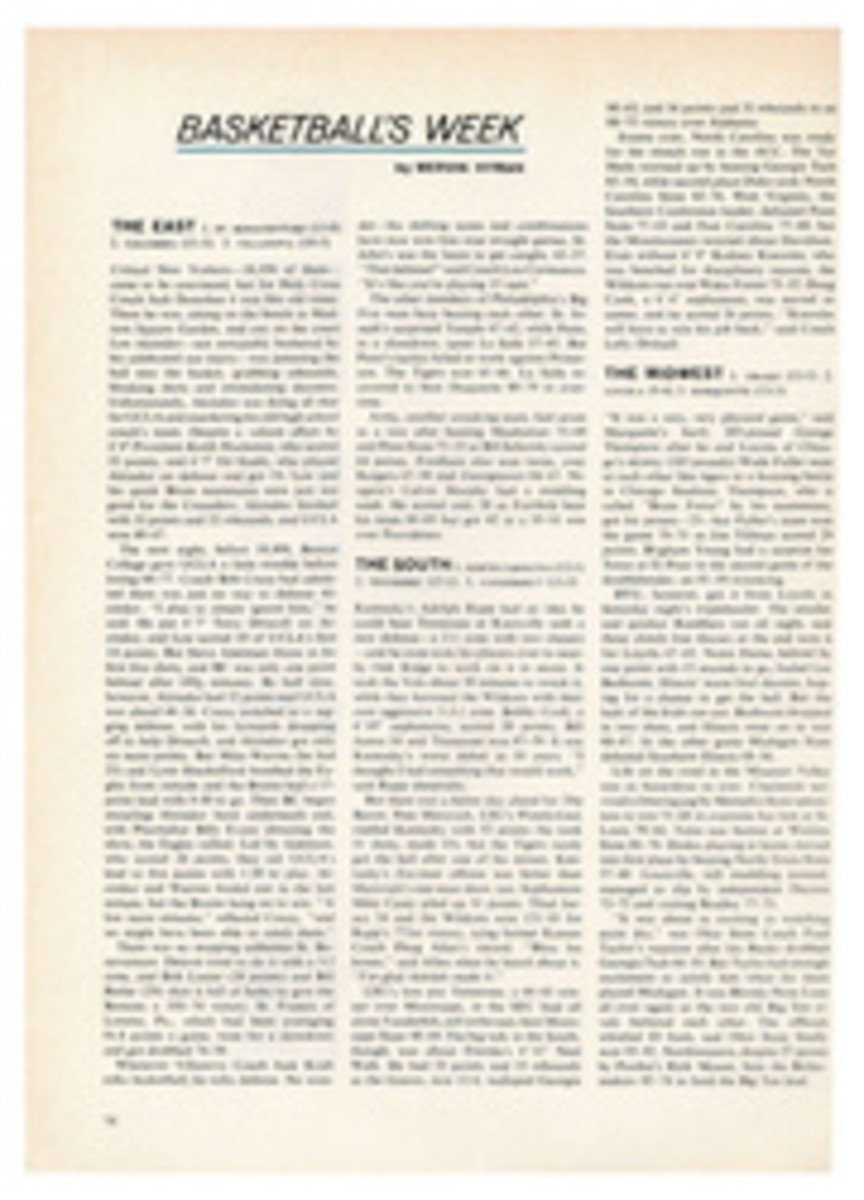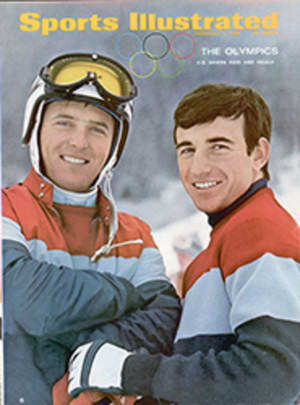
A FIGHT ON THE SLOPES, BUT A CINCH ON THE ICE
Americans oncethought that a Winter Olympics was something that happened in a Sonja Heniemovie, but that was before Squaw Valley and a ski boom that now finds even5,000 Texans belonging to ski clubs. Pre-ski boom and pre-TV, figure skatingand bobsledding were the glamour events of the Games, the first one because ofits grace, the other because of its speed. But today the millions of Americanswho ski identify with the Alpine racer, and ski racing has become for Americansthe No. 1 attraction.
Everybody seemsto have heard of our Olympic medal winners Billy Kidd and Jimmy Heuga (seecover), who once again lead the U.S. Alpine squad, and of their predecessors,Gretchen Fraser, Andrea Mead Lawrence, Penny Pitou, Betsy Snite and JeanSaubert. If you count the medals they have won—10 in all—it appears that mostof our heroes are heroines. But if you count further all the medals that U.S.teams have won since the first Winter Olympics in Chamonix in 1924, you willdiscover that while skiing may be the glamour sport as far as Americans areconcerned, it is not one in which we have exactly covered ourselves with glory.The U.S. has won a total of 63 golds, silvers and bronzes in the Winter Games:19 in figure skating, 14 in speed skating (both events will provide our surestmedals at Grenoble—page 28), 14 in bobsledding, 10 in Alpine skiing, six inhockey and none in the Nordic events.
Win or lose, oneof the major forces responsible for the popularization of Alpine ski racing isBob Beattie, the aggressive coach of our national team, who has had our effortsunder his boot for almost seven years. Beattie has yet to produce a Jean-ClaudeKilly, but what he has done is get the sport on television and keep it there,build a broad national junior racing program and persuade big business tosubsidize it, and help invent the World Cup.
Like most men ofaction, Beattie lives in a tangle of problems and criticism, both at home andabroad. Untiringly, he bores through, twisting rules, defying committees andtraditions, seizing every tiny positive result as a sign of hope. Last weekendhe was at it again, remaking, 10 days before the Games begin, the squad hethinks will do best at Grenoble.
The men's teamwas fairly easy to determine. The leaders, of course, are those two oldcampaigners—old at 24—Billy Kidd and Jimmy Heuga, silver and bronze medalistsin slalom at Innsbruck in 1964. Downhillers Jim Barrows and Dennis McCoy alsoare set, along with slalom and giant-slalom specialists Rick Chaffee and SpiderSabich, and Jere Elliott, who will probably compete in all three events.
Heuga and Kiddare the Americans with the best chance going into the pressure of Grenobleagainst the likes of France's Killy and Guy Périllat and Austria's GerhardNenning and Karl Schranz. They know and understand this pressure and havesurvived it many times before, being the most decorated skiers in U.S.history.
They are totallydifferent types of racers and personalities. Heuga is outgoing, impulsive,impressionable, a neat, friendly, fun-loving young man from Tahoe City, Calif.whose successes come in streaks. His determination is well hidden, but it isthere, usually when the odds are most against his winning. In the InnsbruckOlympic slalom, he was back in the second seed on a steep, rutty course, but heflashed to third place. A week later in Garmisch, he won the single biggesttrophy any American racer ever has won, the Arlberg-Kandahar combined, whippingeveryone who had been an Olympic star the week before.
With Kidd injuredin 1966 and 1967, Heuga carried the whole weight of the U.S. team. Although aslalom specialist, he had to ski the downhill in the world championships inChile and the other two events as well. He raced to fourth place in the worldcombined standings. Last year it was Heuga more than anyone else who pushedFrance's Killy to his brilliant season.
Heuga has beenfar from dazzling in January's pre-Grenoble races, mainly because he is anotoriously slow starter. "I'm beginning to get really nervous now, andthat's good," he said last week. "When I'm sort of on the ropes, that'swhen I've been at my best."
While Heuga is apurely instinctive and emotional racer, Billy Kidd is a scientist. The son of amotel owner in Stowe, Vt., Billy studies a slope like Ben Hogan studies a golfcourse. Slightly intellectual and very introspective, Kidd would be the lastman on a dance floor, just as Heuga would be the first—and best.
Kidd concentratesdeeply not only on a race course, but on his technical moves, and he is anintense equipment worrier. He talks incessantly about, "free feeling"and "tip pressure" and "adhesion." It is a treat to listen toKidd talk about how to run a downhill.
"You starttraining slowly, building up a little more speed on each run," he says."You build up confidence so that on the next run, you want to go faster anddon't have any psychological hangups. You build up so that in the nonstopyou're running just on the line that you want to run in the race. Then in therace, you run everything just a little faster. You run it so that on the steepparts you feel like you weigh 800 pounds, curled up in a ball, and on the flatsyou're a feather and everything is just barely under control. You've run yourbest race when you make it to the bottom and don't want to run down the courseagain."
Kidd's comebackthis season has been one of the big conversational topics on the circuit. Afterbecoming the silver medal winner in 1964 and taking third in the world FIScombined at Innsbruck and after winning three big races in Europe in 1966—hewas actually outracing Killy—Billy suffered one of the two major injuries thatalmost ended his career. The first, an ankle sprain, resulted in a tendonoperation. Then later the same year he broke his leg in downhill training justbefore the 1966 world championships in Portillo, Chile. It was thought that hewould be on crutches for two years.
"It nevercrossed my mind that I wouldn't race again," he says. And he recoveredremarkably soon and was back in training only seven months after his break.
This season Kidd,unlike Heuga, has been one of the top threats on the tour, always hanging inthere with a finish of from sixth to first in everything from slalom todownhill. Last weekend he had his best win of all, just before Grenoble. He wonthe second run of a two-day giant slalom at Megève and was second to France'sBernard Orcel in the combined. "When you're hanging in there close, you'vegot to win sometime," he says.
At GrenobleAmerica's chances to add another medal to its slim collection in men's Alpineevents seem to hinge on two things, then: on Jimmy Heuga ripping off a goodrace from out of nowhere and on Billy Kidd polishing himself to the nthdegree.
For Beattie thegirls have been another kind of problem. The group that went to Europe inNovember was rather dismal. In January Beattie brought over three teen-agers,Kiki Cutter, Judy Nagel and Erika Skinger, all cute, tough and relaxed. Thisimmediately pepped up some of the older girls, but depressed others. The newAmerican girls had few if any FIS points and started back in 40th, 50th andsometimes even 90th positions. But against such odds, there they were,finishing in the top 10 and 20. Europe began to notice, and even French CoachHonoré Bonnet got in the habit of not leaving a race scene until Cutter, Nageland Skinger had skied.
While at firstthere was some doubt that the older girls accepted the teenagers as part of thesquad, this doubt was removed one day in Grindelwald, Switzerland. Judy Nagel,who is only 16, had started 95th in the slalom and had finished a stunning18th. Rosie Fortna thereupon bought Judy's starting numbers secretly for fiveSwiss francs and presented them to her at dinner that evening. "ByGod," said Beattie, "they all understand that we've got to go intoGrenoble with the strongest team the U.S. can have." Before the pre-Olympicraces were over, Judy not only had skied her way onto the team but from thelast to a probable first slalom seed at Grenoble.
Rosie Fortna andSuzy Chaffee all began to speed up. But none roared down the trails any fasterthan Kiki Cutter, an 18-year-old from Bend, Ore. who belies her ladylikecuteness with a fighting temperament. From second-and third-seeding groups,Kiki carved out a second place and two sevenths, a 10th and an 11th. Then atSaint-Gervais last weekend she blazed to third place in slalom, the bestperformance of any American girl so far. She easily made the team, along withJudy Nagel, Wendy Allen, Rosie Fortna, Suzy Chaffee, Karen Budge and RobinMorning. Kiki is the only one who will race in all three events. A favoritewith the men because of her aggressive style, she became a television starwithout knowing it. Frequently able to watch the ladies' races on TV fromanother village, the U.S. men would explode with approval when they saw Cutterstep into the starting gate. And often they heard the tale of Kiki spinningdown a practice run behind France's Marielle Goitschel, hollering at her to gofaster or move over. They told it again and again with admiration. As thepublic-address announcers in Europe identified her name and country,"Kooter, Keekee, Ooh, Ess, Ah," somehow she had become the embodimentof American skiing spirit.
[This articlecontains a table. Please see hardcopy of magazine or PDF.]
TWO ILLUSTRATIONS
PHOTO
Recovered from old injuries, Billy Kidd, shown in Kitzbühel slalom, goes to Grenoble honed for a medal.
PHOTO
Kiki Cutter, new darling of the U.S. ski team, has fought her way into all three events at Chamrousse.

